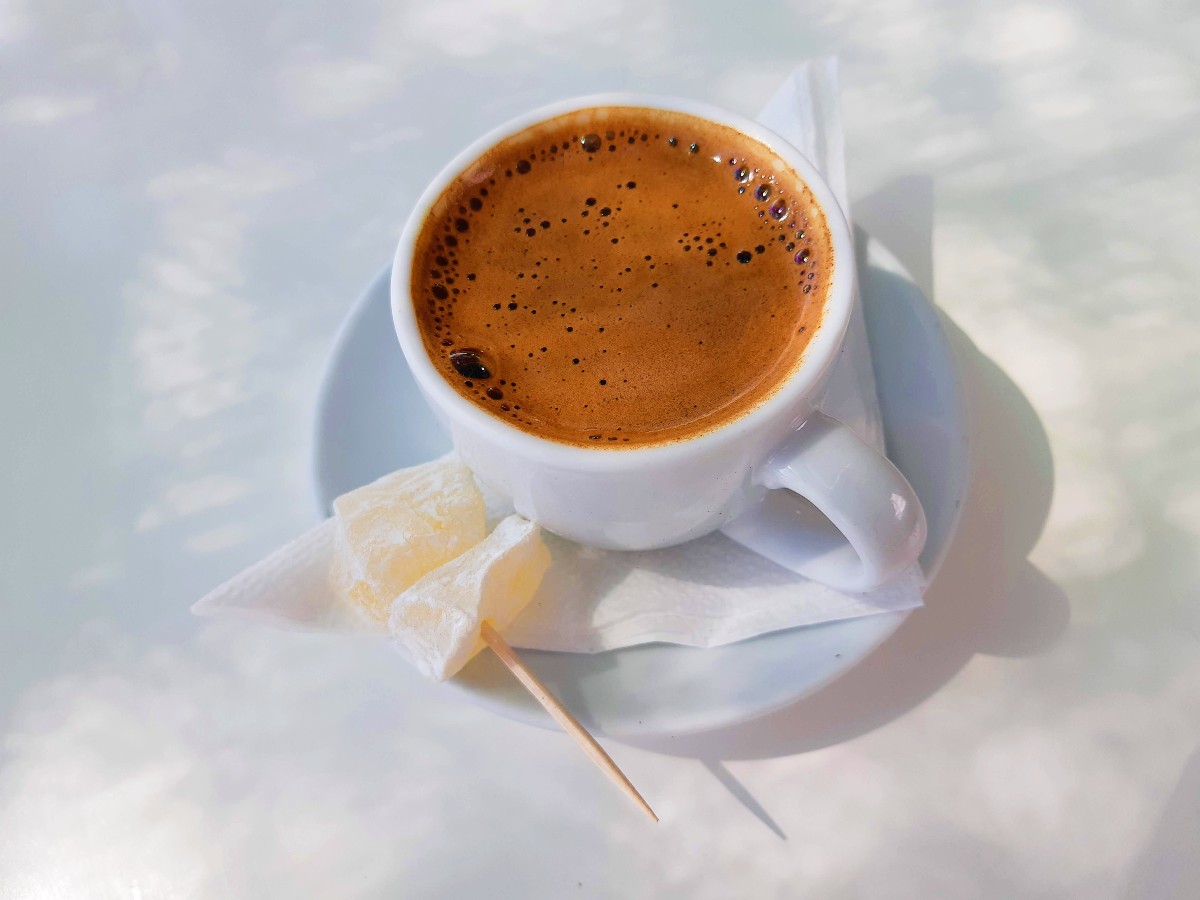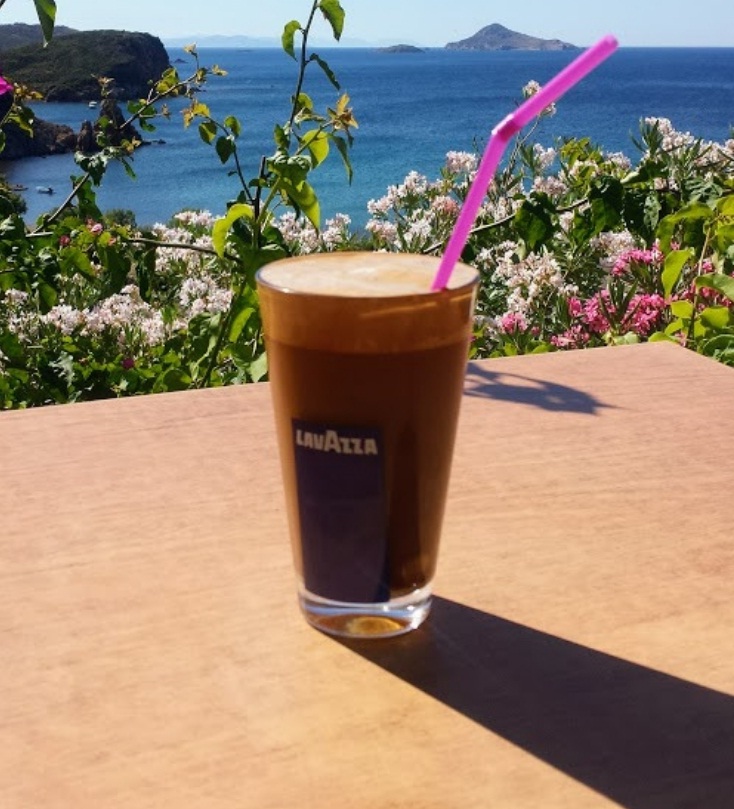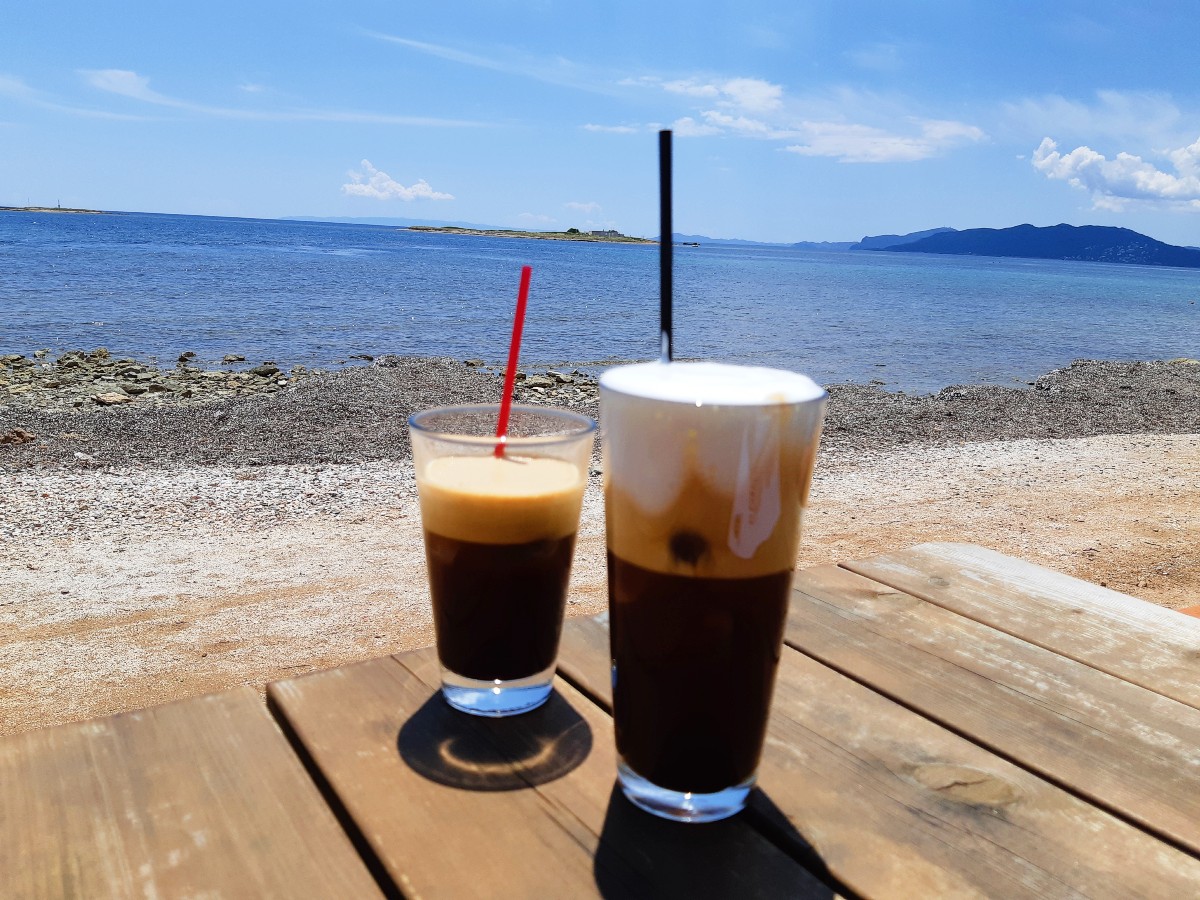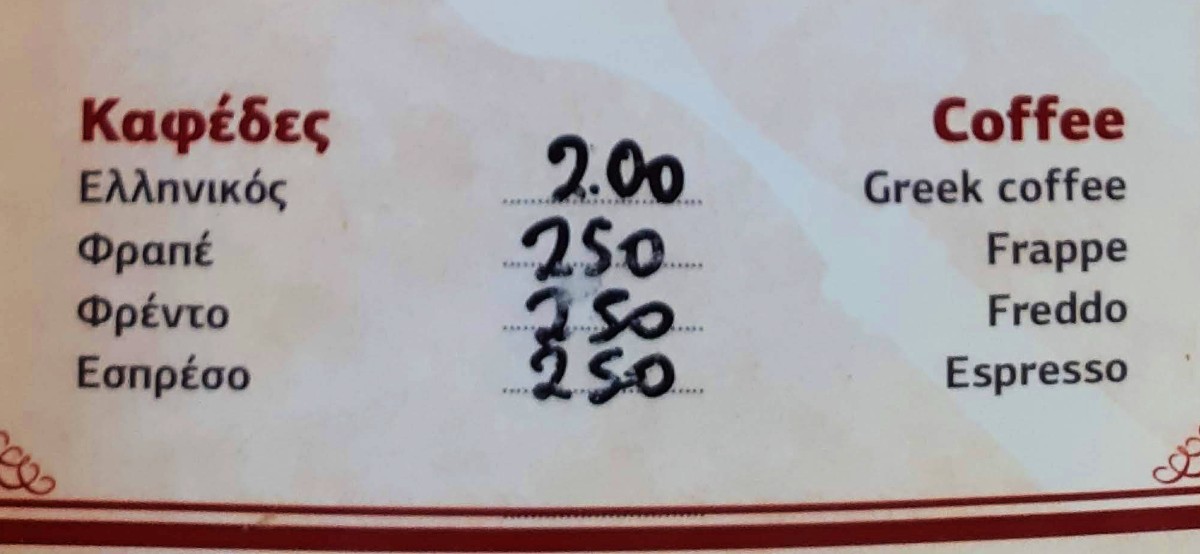Coffee in Greece is a huge part of the Greek culture. It’s much more than just a drink – it’s a pretext for meeting friends and discussing everyday life or serious affairs. Here is everything you need to know about Greek coffee and the coffee culture in Greece.

What is Greek coffee?
Greek coffee is a strong, thick coffee which is prepared after boiling ground Arabica coffee beans in a special pot, called briki.
Traditionally, the pot is placed on coals covered by hot sand, and the coffee simmers until a thin layer of foam (kaimaki) appears on top.
At this stage, the coffee is poured in a special Greek coffee cup. This is often referred to as a demitasse cup, and it’s a little bigger than a normal espresso cup.

You can adjust the quantity of sugar to your liking, from extra sweet, to no sugar at all.
These days, it’s more common to use a gas stove or cooker to prepare Greek coffee. Yet, a handful of coffee shops still use the authentic method!
Greek coffee culture
Having a coffee is a huge thing here in Greece. However, while the drink itself is important, the expression “going for a coffee” doesn’t have much to do with the actual coffee consumption. Instead, it indicates meeting for a chat and a catch-up.
First-time travelers to Greece are always surprised by the numbers of locals sitting around at cafés at any time of the day. But what’s the story behind Greece’s most popular pastime? Let’s find out!
A brief history of coffee and coffee beans
According to legend, coffee was first discovered in Ethiopia in the 9th century AD. A goat herder, Kaldi, noticed that his goats became very energetic after eating the fruit of a yet unknown plant.
Kaldi took the fruit to a monk in a nearby monastery, who made a drink and discovered that it helped him stay awake. This is thought to be how coffee was first discovered.

The drink made its way to Yemen, many Arabic countries and the Ottoman Empire, often replacing alcoholic drinks that were banned by the Quran. It eventually reached Europe in the mid-1600s, and the US a few decades later.
Inevitably, coffee shops started appearing everywhere. They were places where male citizens gathered, discussed, and exchanged political and other opinions. They became an alternative place for men to meet, alongside the bazaars, marketplaces, houses or mosques – similar to the Ancient Agora of Athens.
Coffee shops in Greece
As Greece was a part of the Ottoman Empire, Greeks embraced coffee and coffee culture early on. Several hundreds of cafés existed in Thessaloniki, Kavala and other cities in north Greece long before the Greek Revolution in 1821.
There are conflicting accounts regarding which was the first coffee shop, or kafeneio, in Greece owned by a Greek national. Some people claim that it was founded in Nafplion, the first capital of the Greek state.
According to others, Kafeneio Forlidas on Pelio mountain, which opened in 1785, is the oldest coffee shop in Greece. It’s still in operation, currently owned by the seventh Forlidas generation! You can see what it looks like in this short video.
The first coffee shops in Athens
In 1834, Athens became the capital of modern Greece, and the Bavarian Prince Otto Friedrich Ludwig von Bayern was appointed as the first King. Soon after, the city began to have some entertainment and nightlife, and a few cafés opened.
One of the first establishments at the time was the “Bavarian Café”. Commonly known as “Gruner Baum” (Green Tree), it functioned as a multi-purpose coffee shop / beerhouse / restaurant / library / bowling club. It was mostly frequented by King Otto, Bavarian officers and other expats.

Another popular kafeneio in Athens was “Orea Ellas” (Beautiful Greece), on the corner of Aiolou and Ermou Street, close to today’s Monastiraki metro. Here is where everyone gathered to read the most recent newspapers and discuss political affairs.
During those times, cafés were limited to male patrons. Greek women only started going to cafés a few decades ago. If you visit more remote areas in Greece, you will still see a few kafeneia mainly frequented by old men.
Greek cafes and coffee shops today
These days, coffee shops thrive everywhere in Greece.
In bigger cities, like Athens, you will see modern coffee shops in every little neighbourhood, from bigger chain shops to small family-owned cafés. It’s always easy to sit for a coffee or get one to go, and it’s a daily ritual for many Greeks, often combined with shopping.
In smaller towns and villages, cafés are often the focal point of the community, where locals go to gather together and discuss the latest community news.
There are many different coffees to choose from in Greek coffee shops. From steaming hot coffee to iced coffee, here are the most popular types of coffee in Greece.
Traditional Greek coffee
As mentioned earlier, the so-called “Greek coffee” is an iconic drink which has its roots in the distant past, in Yemen, the Arab countries and the Ottoman Empire.

Both Arabic coffee and Turkish coffee, are inscribed on the UNESCO Intangible Cultural Heritage of Humanity list. Variations exist in several countries in the Mediterranean and the Balkans.
This type of coffee is traditionally served in demitasse cups and meant to be sipped slowly. In Turkey, it is often accompanied by a sweet treat called a Turkish delight.
Greek coffee, or Turkish coffee?
While this coffee was originally known as Turkish coffee in Greece, things changed in the 1960s, mostly for political reasons. Nowadays, Greeks commonly refer to this drink as Greek coffee, or Ellinikos kafes.
As Greek coffee is unfiltered, a sediment consisting of the Greek coffee grounds forms at the bottom of the cup – be careful not to drink it! And even if you are not a huge coffee drinker, you should indulge in a cup of Greek coffee once, just for the experience.
Finally, believe it or not, there’s a cold version of Greek coffee that you can find at a few cafes in Athens – it’s called Frio!
Greek Frappé coffee
Frappé coffee is one of the most famous types of coffee in Greece. It consists of instant coffee (or decaf coffee) shaken together with cold water and a few ice cubes, with optional milk and sugar. The iced drink is served in a tall glass, with a straw, and has a thick layer on foam on top.

According to urban legend, Greek frappé was invented during the International Trade Fair of Thessaloniki, in 1957. One of the companies exhibiting their products was Nestlé, the famous food and drink company.
Among other consumer goods, Nestlé was promoting their usual instant coffee. As hot water was not available, one of their employees tried mixing cold water with the easily soluble coffee, to make an uplifting drink.
The rest, as they say, is history. Frappé became a huge part of the Greek coffee scene. The image of the iced drink in a cold glass is linked to summer, long chats, and care-free holidays.
Fun fact: The word “frappé” comes from the French word “frapper”, meaning “to knock / hit”.
How to make the perfect frappé iced coffee
The most common coffee to use for a Greek frappé is Nestlé’s Nescafé. These days, there are many other brands producing spray dried instant coffee, and each of them may have several products. I prefer Jacobs Gold myself!
You can make a frappé using a shaker, but it’s best to use a special hand mixer / milk frother.
Pour a small amount of water in a tall glass, add 1-2 teaspoons of instant coffee, and sugar to taste (optional). Mix with the hand mixer, until a thick foam appears on top. Add some cold water, ice cubes, and milk to taste (optional).
Your cold coffee is ready. Serve with a straw, and enjoy!
Note: Unlike a coffee milkshake, this beverage typically has very few calories. If you are not used to it, it can be hard on your digestive system, so proceed with caution!
Espresso and cappuccino
Espresso and cappuccino, which were invented in Italy at the beginning of the 20th century, are very common throughout Greece. These days, most cafés have Italian espresso machines.

The Italian word “espresso” is widely used to describe a small shot of coffee with a strong flavor, served in a special cup. The brewing method uses high water pressure and finely ground coffee beans.
Cappuccino contains a double shot of espresso coffee along with steamed milk and milk foam on top. Its name may derive from the Capuchin monks, whose robes brown color was similar to that of the hot drink.
Freddo espresso and freddo cappuccino
Espresso freddo and cappuccino freddo are two fairly recent additions to the Greek coffee culture. They are the cold versions of espresso and cappuccino, and are steadily gaining ground against the frappé, with many Greeks ordering them as a take-away.

To make a great freddo espresso, you will first need to make a double shot of espresso. Pour it in a metal shaker with (optional) sugar and ice cubes, shake it for a few seconds, and pour it over a glass with some more ice cubes.
For freddo cappuccino, just add a few tablespoons of frothed milk on top.
Good coffee beans are essential to make these cold coffees. Common brands in Greece are Illy, Lavazza, Dimello and Buondi. Again, you can gave decaf versions if you prefer.
French coffee / Filter coffee
While filter coffee is available at coffee shops in Greece, it is not among the most popular types of coffee. Unlike traditional Greek coffee or espresso, it is light in flavor, and typically contains less caffeine.
You can ask for it as French coffee, or Gallikos in Greek. Common brands include Jacobs, Dimello, and the signature Coffeeway. They often come in different flavors, such as vanilla, hazelnut or caramel.
Cold brew coffee
Some modern coffee shops in Greece offer the option of a cold brew coffee. This takes several hours to prepare – the coffee is immersed in cold water, and as such it takes a much longer time to release its aroma.
Ordering coffee in Greece
When ordering some types of coffee in Greece, your waiter will typically ask you how much sugar you want. This is because they might need to add the sugar at the time of preparation.
You can ask for your coffee to be extra sweet (glykos), medium sweet (metrios) or without sugar (sketos). My granddad preferred his authentic Greek coffee with extra coffee and extra sugar, which we call vary glykos in Greek.
It’s also possible to order a double coffee (diplos). This usually applies for Greek coffee, espresso and cappuccino – there isn’t such a thing as a diplos frappé.
If you want milk in your frappé or filtered coffee, the Greek words you can use are “me gala”. Different types of vegan milk. e.g. almond milk or oat milk, are becoming increasingly popular but you won’t always find the,.
All of the above are usually available as decaf versions, and many cafés will also offer various sugar substitutes, like coconut sugar, stevia etc.

Prices at coffee shops depend on where you go. Generally speaking, the price of a coffee will be around 2.50-4.50 euro, but it will be higher in touristy areas in places like Athens, Mykonos and Santorini.
A take-away coffee, however, costs from as little as 1.50-2 euro – which explains why it’s so popular.
FAQs about Greek coffee and the Greek coffee culture
Here are a few questions visitors have asked me in the past:
Is coffee popular in Greece?
Coffee is one of the most popular drinks in Greece today, and Greeks enjoy it at most times of the day. There are literally hundreds of coffee places everywhere around the country, and coffee drinking is a huge part of the Greek culture.
What kind of coffee do they drink in Greece?
Some of the most common Greek coffees today are frappé, freddo espresso, freddo cappuccino and the so-called Greek coffee.
How do Greek people drink coffee?
Drinking coffee can be described as Greece’s national sport. Greeks drink coffee everywhere, at almost any time of the day. You will see dozens of people sitting at cafés, but also people with a take-away coffee in their hand, taking short coffee breaks.
How do you ask for coffee in Greek?
The Greek phrase you would use to ask for a coffee is enan kafe parakalo. However, you’d have to specify what type of coffee you want. If you are visiting Greece on a holiday, you should aim to drink Greek coffee and frappé at least once.
What is the difference between Greek coffee and Turkish coffee?
There is no real difference between Greek and Turkish coffee, though the coffee grounds that you find in the two countries might be of different origin. When in Greece, it’s best to refer to the traditional coffee as Greek coffee.
Coffee and coffee culture in Greece
I hope you enjoyed this article about the Greek coffee culture. Here are a few more articles you might like:
- Popular Greek drinks
- Food of Greece – 50 Greek dishes
- How to order food in Greece
- Why are buildings in the Cyclades painted blue and white
- Quotes about Greece
- Useful words and phrases in Greek
- What to do on a Sunday in Athens
Do you have any insights into the cultural significance of coffee in Greece? Leave a comment below!
 Hi! I’m Vanessa from Athens, and, like most Greeks, I love meeting friends for coffee – preferably a cold one! Follow me on my social media:
Hi! I’m Vanessa from Athens, and, like most Greeks, I love meeting friends for coffee – preferably a cold one! Follow me on my social media:
- Facebook page and very active Facebook group
- Amazon

